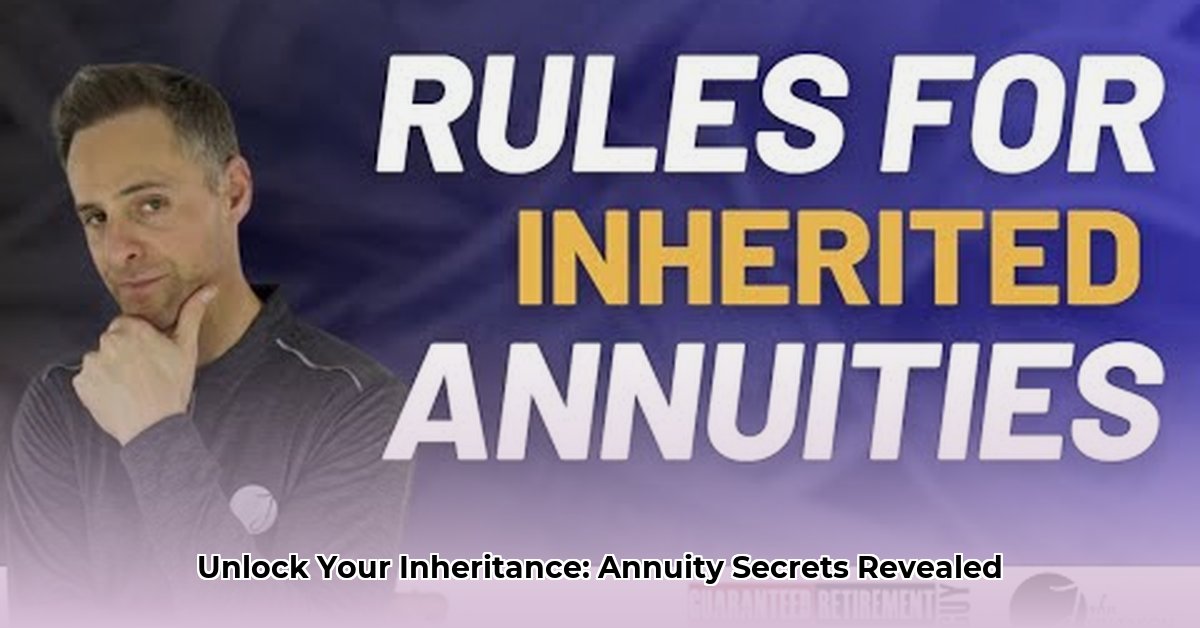
Understanding Inherited Non-Qualified Annuities
Inheriting a non-qualified annuity can feel overwhelming. Unlike inheriting cash or stocks, annuities have specific distribution rules and tax implications that significantly impact your financial future. This guide provides a clear, actionable pathway to navigate these complexities, maximizing your inheritance. We'll demystify the process, focusing on making informed decisions. A critical element to remember is the 60-day rule—a crucial timeframe for making key decisions post-inheritance. Understanding this deadline is crucial for avoiding potential tax penalties.
Distinguishing Qualified vs. Non-Qualified Annuities
An annuity is essentially a contract where you (or, in this case, the deceased) invest money that grows tax-deferred. Qualified annuities, such as 401(k)s and traditional IRAs, offer tax advantages during the growth and distribution phases for the original owner. Non-qualified annuities differ significantly. The tax-deferral applies only while the original owner is alive and receiving payments. Upon their death, the tax-deferred growth ceases, impacting your tax liability upon distribution. This key distinction dictates the unique rules governing inherited non-qualified annuity payouts.
Beneficiary Types and Distribution Choices: Spouses vs. Non-Spouses
The rules vary significantly depending on whether you're the spouse or a non-spouse beneficiary.
Spouses: Typically, spouses have more flexibility and options, potentially including rolling the annuity over into their own retirement accounts (a 1035 exchange) without immediate tax consequences. However, always review the specific annuity contract terms.
Non-Spouses: For non-spouses, the landscape is more complicated. A key consideration is the “10-year rule,” introduced by the SECURE Act of 2019, mandating distribution of the entire inherited annuity within 10 years of the owner's death. This eliminates the traditional "stretch IRA" strategy, which allowed for longer, more tax-efficient withdrawals. The 60-day rule still applies, emphasizing the urgency of making informed decisions promptly after inheritance.
Choosing Your Payout Method: Three Key Strategies
You have three primary payout options, each with distinct tax implications:
Lump-Sum Distribution: Receive the entire amount at once. This simplifies matters but results in immediate taxation of the entire distribution, potentially pushing you into a higher tax bracket.
Fixed-Period Payments: Receive regular payments over a predetermined period (e.g., 5, 10, or more years). This offers predictability but payments cease at the end of the term regardless of your lifespan. Each payment is partially taxable.
Life-Contingent Payments: Receive payments for the remainder of your life. This guarantees lifetime income but usually entails smaller individual payments. Each payment involves a complex calculation using the exclusion ratio, determining the taxable portion. Did you know that the complexity of this calculation often warrants professional tax advice?
| Payout Option | Advantages | Disadvantages | Tax Implications |
|---|---|---|---|
| Lump Sum | Simplicity, immediate access | High tax liability, potential for higher tax bracket | Taxed entirely in the year of receipt |
| Fixed-Period | Predictable income, easier tax planning | Payments stop after a fixed term; inflexibility | Partial taxation on each payment |
| Life-Contingent | Lifetime income | Smaller payments, complex tax calculation | Partial taxation on each payment; complex calculation |
The best approach depends significantly on your age, financial situation, risk tolerance, and long-term financial goals. Considering your individual circumstances is paramount.
Navigating Tax Implications: Understanding the 1099-R
The IRS Form 1099-R details your annuity distributions, separating the tax-free principal (your inheritance) from the taxable earnings (the annuity's growth). Only the earnings portion is subjected to income tax. Accurately calculating this proportion can be complex, especially for annuities without prior distributions.
Exploring the 1035 Exchange: A Potential, but Conditional, Strategy
A 1035 exchange allows a tax-free transfer of your inherited annuity to another annuity or qualified retirement plan. While potentially advantageous in certain situations, it's a complex manoeuvre that demands expert review and careful consideration of the suitability for your financial status. It's not a universally beneficial strategy.
The Importance of Professional Guidance: Why Expert Help is Crucial
Successfully navigating inherited non-qualified annuities requires specialized knowledge. Professional financial and tax advisors provide invaluable assistance, guiding you through complex calculations, explaining diverse options, and creating a personalized plan that aligns with your individual financial circumstances and risk tolerance. Failing to seek qualified assistance might lead to costly mistakes, making the upfront investment well worth the potential savings in the long run. Don't hesitate to leverage expert expertise.
Key Takeaways: Actionable Steps for Maximizing Your Inheritance
- Understand the difference: Distinguish between qualified and non-qualified annuities. This foundational understanding shapes your tax strategy.
- Know your beneficiary status: Your relationship to the deceased (spouse versus non-spouse) drastically alters the rules and available options. The 10-year rule for non-spouses is particularly important.
- Choose wisely: Carefully select your payout strategy (lump sum, fixed period, or life contingent), considering your individual circumstances and financial goals. Don't make this crucial decision without thorough professional advice.
- Seek expert guidance: Consulting a financial advisor and tax professional is indispensable. Their expertise ensures informed decisions, optimizing your tax liability and safeguarding your financial future. Don't underestimate the value of this support; it's an investment in your financial well-being.